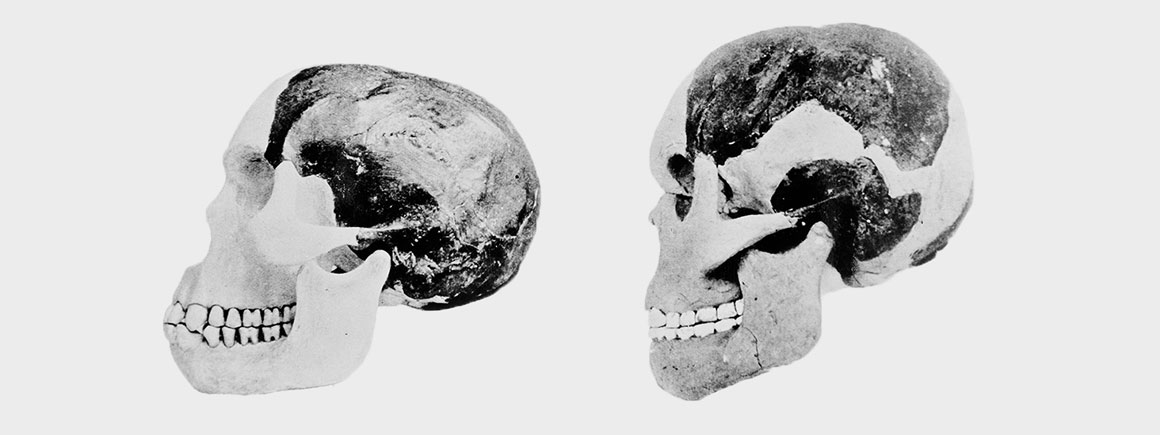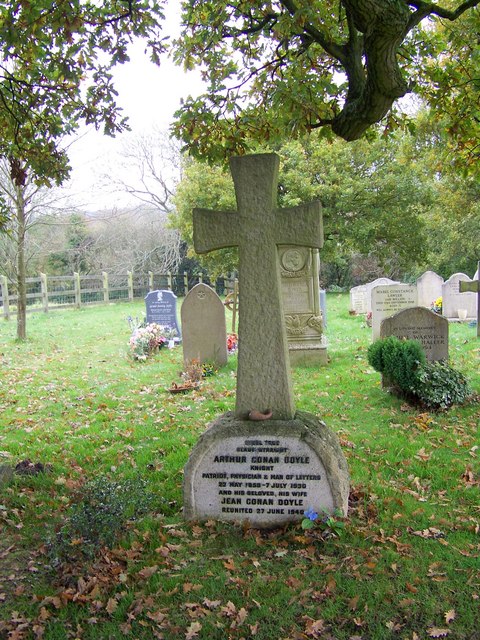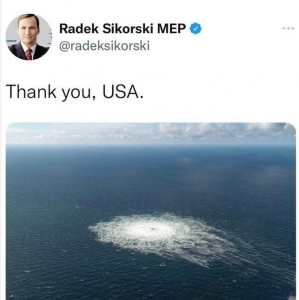2018年8月8日 水曜日 晴れ
三井誠 人類進化の700万年 書き換えられる「ヒトの起源」 講談社現代新書 2005年
・・科学的な手法で、ピルトダウン頭骨を詳しく調べたところ、原始的な特徴を持つとされた下あごの化石は、現代のオランウータンの骨を人工的に着色し古さを偽装していたことがわかった。頭のほうは現代人のものであることがわかった。一緒に発掘された石器や動物骨なども、細工を施して古く見せかけていたことが明らかになった。二十世紀前半の人類学者にもてはやされたピルトダウン頭骨は捏造だった。「大きな脳こそが人類にふさわしい」という当時の信仰が、捏造を受け入れる土壌だった。
・・人類の進化はまずは二足歩行と歯の変化から始まり、その舞台はアフリカであることがほぼ確立した。(三井、同書、p260-261)
**
補注 ウィキペディアによると・・・
ピルトダウン人(ピルトダウンじん、英語名:Piltdown Man)は、近代科学史上で最大のいかさまとして知られる、捏造された化石人類。「ピルトタウン人 」と表記されることもまれにあるが、townではないため正しくない。20世紀初頭のイギリスはイースト・サセックス州アックフィールド(Uckfield)近郊のピルトダウンにて「発見」され、20世紀の前半期の古人類学研究に多大な悪影響を与え、迷走させた。
当時の学名は Eoanthropus dawsoni (エオアントロプス・ドーソニ。「ドーソンの、夜明けの人」の意)。 日本語では第一発見者の名から「ドーソン原人」、属名 Eoanthropus の漢訳で「曙人」などとも呼ばれた。
・・・(中略)・・・

ウッドワード卿が復元したピルトダウン人頭骨。大きく膨らんだ脳頭骨と、突出した原始的な顎に注意。
フッ素法
骨が地中に埋もれると、土中の水分や地下水に含まれる微量のフッ素が骨組織内に入り込み、フッ素の含有量が増えていく。したがって、骨に含まれているフッ素の量を測定すればその古さを推定することができる。水分中のフッ素量は地域によって異なるため、遠く隔たった土地から出土した骨の比較や絶対年代の測定はできないが、同一地点や近接した地域から出たものの相対的な古さを知るには優れた方法である。
この手法は19世紀になってヨーロッパで断続的に行なわれるようになり、第二次世界大戦後にロンドン自然史博物館のケネス・オークリー(Kenneth Oakley)によって確立された。
捏造の発覚
1949年、ケネス・オークリーがフッ素法でピルトダウン人頭骨の年代測定を行い、骨が5万年前 のものであることを明らかにした。これによりピルトダウン人が類人猿と現生人類のミッシングリンクであることが否定された[5][6]。 加えて1953年にはオークリー率いるオックスフォード大学の研究者らによるいっそう精密な年代測定と調査・分析が行われ、その結果、下顎骨はオランウータンのものであり、臼歯の咬面は人類のそれに似せて整形されていたこと、古く見えるよう薬品と思われるものにより石器などとともに着色されていたこと、伴出した獣骨は他の地域の産であることなどが突き止められた。 類人猿の下顎骨は人骨とは決して接合できないものであるが、捏造犯は接合部分を巧妙に除去して矛盾を隠し、着色を施して偽装したとのことである。
のものであることを明らかにした。これによりピルトダウン人が類人猿と現生人類のミッシングリンクであることが否定された[5][6]。 加えて1953年にはオークリー率いるオックスフォード大学の研究者らによるいっそう精密な年代測定と調査・分析が行われ、その結果、下顎骨はオランウータンのものであり、臼歯の咬面は人類のそれに似せて整形されていたこと、古く見えるよう薬品と思われるものにより石器などとともに着色されていたこと、伴出した獣骨は他の地域の産であることなどが突き止められた。 類人猿の下顎骨は人骨とは決して接合できないものであるが、捏造犯は接合部分を巧妙に除去して矛盾を隠し、着色を施して偽装したとのことである。
こうして40年近くにわたって古人類学界を混乱させたピルトダウン人は捏造された化石であると断定され、事件は一応の決着を見た。ただし、最初にドーソンからもたらされた頭頂骨と側頭骨は、後期更新世に由来する化石の現生人類(クロマニョン人の類)と考えられている。
犯人は誰か
犯人については様々な説がある。第一発見者のチャールズ・ドーソンが疑われたのは当然で、すでに当初から疑惑がささやかれていたのは上述の通りである。2016年にロンドン自然史博物館などがまとめた研究成果では、骨の標本の分析などを行うことで、第一発見者のチャールズ・ドーソンを犯人とほぼ断定している[7]。しかし一方では、彼は単に利用されただけで真相は知らなかったとする意見もある。
古人類学が黎明期にあったとはいえ、長らく専門学者たちをだまし続けるほどの偽物を造るには高度の知識と技術が必要であるとして、当時の研究者であるウッドワード・キースやエリオット・スミスなどの犯行とする説もある。
1983年には『シャーロック・ホームズ』シリーズの作者として有名な作家アーサー・コナン・ドイルが犯人であるとの説が出されている。彼がピルトダウン近郊の住人であったこと、医師を本業としていて骨を捏造し得る知識があったこと、ホームズ物の他に『失われた世界』のようなSF小説も書いており、古生物や古代世界に関心があったことなどが論拠とされている。
イギリスの科学雑誌『ネイチャー』は、発見された遺品を根拠として、ロンドン自然史博物館に学芸員として勤めていた、げっ歯類を主とする動物学者マーティン・ヒントン(Martin A.C. Hinton)なる人物が真犯人であったとする説を1996年5月23日号に掲載した。同博物館の屋根裏からヒントンの旅行鞄が発見されその中からピルトダウン人の加工と同じような処理が施されたゾウ、カバの化石が発見された。またヒントンは化石の変色についての論文を発表しており、これもまたピルトダウン人の人骨の染色と似たような方法が施されていた。ヒントン犯行説は、ウッドワードに対する怨恨(薄給、仕事を回さない)が犯行動機であったと説明する。(但し、ヒントンは発掘現場へ足を運んだ形跡が無い、との説もある)
様々な容疑者が取り沙汰されるも、ピルトダウン化石の捏造が明らかになった前後に関係者らはことごとく他界しており、真相の究明は非常に困難である。
<以上、ウィキペディアより引用終わり>
*****

Piltdown Man cranium and mandible as reconstructed by Dr Arthur Smith Woodward (L) and Professor Arthur Keith (R) http://www.nhm.ac.uk/our-science/departments-and-staff/library-and-archives/collections/piltdown-man.html より引用。
In 1912 Charles Dawson, an amateur archaeologist claimed to have discovered the ‘missing link’ between ape and man. He had found part of a human-like skull in Pleistocene gravel beds near Piltdown village in Sussex, England.
Dawson wrote to Arthur Smith Woodward, Keeper of Geology at the Natural History Museum at the time, about his find.
Dawson and Smith Woodward started working together, making further discoveries in the area. They found a set of teeth, a jawbone, more skull fragments and primitive tools, which they suggested belonged to the same individual.
Smith Woodward made a reconstruction of the skull fragments, and the archaeologists hypothesised that the find indicated evidence of a human ancestor living 500,000 years ago. They announced their discovery at a Geological Society meeting in 1912. For the most part, their story was accepted in good faith.
However, in 1949 new dating technology arrived that changed scientific opinion on the age of the remains Using fluorine tests, Dr Kenneth Oakley, a geologist at the Natural History Museum, discovered that the Piltdown remains were only 50,000 years old. This eliminated the possibility of the Piltdown Man being the missing link between humans and apes as at this point in time humans had already developed into their Homo sapiensform.
Following this, biological anthropologist Dr Joseph Weiner and human anatomist Wilfrid Le Gros Clark, both from Oxford University, worked with Dr Oakley to further test the age of the Piltdown findings. Their results showed that the skull and jaw fragments actually came from two different species, a human and an ape, probably an orangutan.
Scratches on the surfaces of the teeth, visible under the microscope, revealed that the teeth had been filed down to make them look human. They also discovered that most of the finds from the Piltdown site had been artificially stained to match the local gravels.
The conclusion: Piltdown Man was an audacious fake and a sophisticated scientific fraud.
We hold many documents and photographs relating to the Piltdown Man, including correspondence between Woodward Smith and Dr Oakley and communications within the Museum’s palaeontology department. The Museum also has a large collection of photographs of the original findings and cranial restoration. There are also a number of Museum publications on the Piltdown story.
http://www.nhm.ac.uk/our-science/departments-and-staff/library-and-archives/collections/piltdown-man.html より引用。
**
補注 英語版のウィキペディアによると・・・
Identity of the forger
The identity of the Piltdown forger remains unknown, but suspects have included Dawson, Pierre Teilhard de Chardin, Arthur Keith, Martin A. C. Hinton, Horace de Vere Cole and Arthur Conan Doyle.[13][14]
The focus on Charles Dawson as the main forger is supported by the accumulation of evidence regarding other archaeological hoaxes he perpetrated in the decade or two before the Piltdown discovery. The archaeologist Miles Russell of Bournemouth University analysed Dawson’s antiquarian collection, and determined that at least 38 of his specimens were fakes.[15][16] Among these were the teeth of a reptile/mammal hybrid, Plagiaulax dawsoni, “found” in 1891 (and whose teeth had been filed down in the same way that the teeth of Piltdown Man were to be some 20 years later); the so-called “shadow figures” on the walls of Hastings Castle; a unique hafted stone axe; the Bexhill boat (a hybrid seafaring vessel); the Pevensey bricks (allegedly the latest datable “finds” from Roman Britain); the contents of the Lavant Caves (a fraudulent “flint mine”); the Beauport Park“Roman” statuette (a hybrid iron object); the Bulverhythe Hammer (shaped with an iron knife in the same way as the Piltdown elephant bone implement would later be); a fraudulent “Chinese” bronze vase; the Brighton “Toad in the Hole” (a toad entombed within a flint nodule); the English Channel sea serpent; the Uckfield Horseshoe (another hybrid iron object) and the Lewes Prick Spur. Of his antiquarian publications, most demonstrate evidence of plagiarism or at least naive referencing, Russell wrote: “Piltdown was not a ‘one-off’ hoax, more the culmination of a life’s work.”[17] In addition, Harry Morris, an acquaintance of Dawson, had come into possession of one of the flints obtained by Dawson at the Piltdown gravel pit. He suspected that it had been artificially aged – “stained by C. Dawson with intent to defraud”. He remained deeply suspicious of Dawson for many years to come, though he never sought to discredit him publicly, possibly because it would have been an argument against the eolith theory, which Morris strongly supported.[18]
Professor Adrian Lister of the UK’s Natural History Museum has said that “some people have suggested” that there may also have been a second ‘fraudster’ seeking to use outrageous fraud in the hope of anonymously exposing the original frauds. This was a theory first proposed by Miles Russell.[19] He has explained that the piece nicknamed the ‘cricket bat’ (a fossilised elephant bone) was such a crudely forged ‘early tool’ that it may have been planted to cast doubt upon the other finds, the ‘Earliest Englishman’ in effect being recovered with the earliest evidence for the game of cricket. This seems to have been part of a wider attempt, by disaffected members of the Sussex archaeological community, to expose Dawson’s activities, other examples being the obviously fraudulent ‘Maresfield Map’, the ‘Ashburnham Dial’, and the ‘Piltdown Palaeolith’.[20][21]Nevertheless, the ‘cricket bat’ was accepted at the time, even though it aroused the suspicions of some and ultimately helped lead to the eventual recognition of the fraud decades later.[22]
In 2016, the results[23] of an eight-year review[24] of the forgery were released, identifying Dawson’s modus operandi. Multiple specimens demonstrated the same consistent preparation: application of the stain, packing of crevices with local gravel, and fixation of teeth and gravel with dentist’s putty. Analysis of shape and trace DNA showed that teeth from both sites belonged to the same orangutan.[24] The consistent method and common source indicated the work of one person on all the specimens, and Dawson was the only one associated with Piltdown II. The authors did not rule out the possibility that someone else provided the false fossils to Dawson, but ruled out several other suspects, including Teilhard de Chardin and Doyle, based on the skill and knowledge demonstrated by the forgeries, which closely reflected ideas fashionable in biology at the time.
Teilhard de Chardin had travelled to regions of Africa where one of the anomalous finds originated, and resided in the Wealden area from the date of the earliest finds. Hinton left a trunk in storage at the Natural History Museum in London that in 1970 was found to contain animal bones and teeth carved and stained in a manner similar to the carving and staining on the Piltdown finds. Phillip Tobias implicated Arthur Keith in helping Dawson by detailing the history of the investigation of the hoax, dismissing other theories, and listing inconsistencies in Keith’s statements and actions.[25] Other investigations suggest that the hoax involved accomplices rather than a single forger.[26]
補注 英語のウィキペディアの方が情報量が多い。

Group portrait of the Piltdown skull being examined. Back row (from left): F. O. Barlow, G. Elliot Smith, Charles Dawson, Arthur Smith Woodward. Front row: A. S. Underwood, Arthur Keith, W. P. Pycraft, and Ray Lankester. Note the portrait of Charles Darwin on the wall. Painting by John Cooke, 1915.
補注 「新規の動物の捏造」ということであれば、「兵士シュヴェイクの冒険」の著者ハシェク氏が動物学雑誌に次々と新しい動物を記載していたことを(当該雑誌の非購読者の私としては微笑ましく)思い出す。それとほぼ同じ頃、このピルトダウン頭骨の捏造事件が進行中であったことになる。英国紳士たちが真剣に自分たちの祖先を探究している姿が、微笑ましいやら空恐ろしいやら・・私自身は捏造論文に振り回されて何年かを棒に振った職業科学犠牲者のひとりとして誠に遺憾である。が、真実よりも名声や利益を追求する職業科学者の世界では例外というよりも当たり前の日常ということかもしれない。人類学的な課題としては、「チンパンジーにも類似の行動が見られるかどうか?」・・捏造でない真実の回答に繋がる根拠をお教えいただきたいものである。
補注 180810追記 捏造関連の考察は以前にもウェブに公開したことがあります。「捏造、偽装、換骨奪胎。(第一部)」<http://www.sapmed.ac.jp/~hhamada/page2-1-060125>


**
*****
********************************************


**
*****
********************************************






